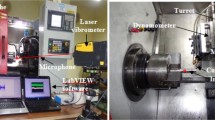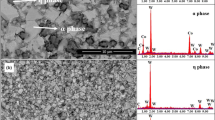Abstract
The present work is aimed at in-process estimation of surface roughness using cutting parameters along with cutting force, sound, and vibration in turning of Inconel 718 with cryogenically treated and untreated carbide inserts. Initially, prediction models are developed by regression analysis using only cutting parameters and then using only force, sound, and vibration. Later on, these models are modified to include all the parameters after performing correlation analysis for determining significant parameters. The modified models are developed using only significant parameters from the cutting parameters and measured responses. The prediction results of modified regression models are compared with experimental results and fine association of fit between measured and estimated surface roughness is confirmed. Based on coefficient of determination (R 2) values, the regression models are found to be better for estimating surface roughness. Finally, it is found that modified regression models are estimating surface roughness with more than 90% accuracy which can be said as acceptable for the two types of inserts used. Use of sound emitted while machining along with values of cutting parameters, force, and vibration to predict surface roughness has not been reported earlier particularly for Inconel 718. As cutting force, sound, and vibration can be measured during the turning process, this method can be useful for real-time control of the process to get the desired surface roughness for machining of difficult to cut material like Inconel 718.



Similar content being viewed by others
Abbreviations
- CNC:
-
Computer numerical control
- CCD:
-
Central composite design
- MRA:
-
Multiple regression analysis
- RSM:
-
Response surface methodology
- FOEC :
-
First-order equation using cutting parameters
- FOER :
-
First-order equation using response parameters
- FOEM :
-
Modified first-order equation
- PCA:
-
Pearson correlation analysis
- v :
-
Cutting speed (m/min)
- f :
-
Feed rate (mm/rev)
- d :
-
Depth of cut (mm)
- F c :
-
Cutting force (N)
- S :
-
Sound pressure level (Pa)
- V v :
-
Vibration velocity (m/s)
- n :
-
Number of experiments
- \(R_{\text{ai}}\) :
-
Average of measured surface roughness in μm
- \(\hat{R}_{\text{ai}}\) :
-
Estimated surface roughness
- R 2 :
-
Coefficient of determination
- AE:
-
Absolute error (%)
- MAE:
-
Mean absolute error (%)
- MSE:
-
Mean square error (%)
References
Blau PJ (2008) Friction science and technology: from concepts to applications. CRC Press, Boca Raton
Benardos PG, Vosniakos GC (2003) Predicting surface roughness in machining: a review. Int J Mach Tools Manuf 43(8):833–844. doi:10.1016/S0890-6955(03)00059-2
Whitehouse DJ (1994) Handbook of surface metrology. Inst. Physics publishing, Bristol and Philadelphia
Fang XD, Safi-Jahanshahi H (1997) A new algorithm for developing a reference-based model for predicting surface roughness in finish machining of steels. Int J Prod Res 35(1):179–199
Wang H, Li D (2002) Surface roughness prediction model for ultraprecision turning aluminium alloy with a single crystal diamond tool. Chin J Mech Eng (Engl Ed) 15(2):153–156
Krolczyk GM, Legutko S (2014) Experimental analysis by measurement of surface roughness variations in turning process of duplex stainless steel. Metrol Meas Syst 21(4):759–770
Pusavec F, Deshpande A, Yang S, M’Saoubi R, Kopac J, Dillon OW Jr, Jawahir IS (2014) Sustainable machining of high temperature Nickel alloy—Inconel 718: part 1—predictive performance models. J Clean Prod 81:255–269. doi:10.1016/j.jclepro.2014.06.040
Davoodi B, Tazehkandi AH (2014) Cutting forces and surface roughness in wet machining of Inconel alloy 738 with coated carbide tool. Proc Inst Mech Eng Part B J Eng Manuf. 230(2):215–226. doi:10.1177/0954405414542990
Bhardwaj B, Kumar R, Singh PK (2014) Prediction of surface roughness in turning of EN 353 using response surface methodology. Trans Indian Inst Met 67(3):305–313. doi:10.1007/s12666-013-0346-7
Ezilarasan C, Kumar VSS, Velayudham A, Palanikumar K (2011) Modeling and analysis of surface roughness on machining of Nimonic C-263 alloy by PVD coated carbide insert. Trans Nonferrous Metals Soc China 21(9):1986–1994
Santhanakumar M, Adalarasan R, Siddharth S, Velayudham A (2017) An investigation on surface finish and flank wear in hard machining of solution treated and aged 18% Ni maraging steel. J Braz Soc Mech Sci Eng 39(6):2071–2084
Yahya E, Ding G, Qin S (2016) Prediction of cutting force and surface roughness using Taguchi technique for aluminum alloy AA6061. Aust J Mech Eng 14(3):151–160
Ezugwu EO, Fadare DA, Bonney J, Da Silva RB, Sales WF (2005) Modelling the correlation between cutting and process parameters in high-speed machining of Inconel 718 alloy using an artificial neural network. Int J Mach Tools Manuf 45(12–13):1375–1385. doi:10.1016/j.ijmachtools.2005.02.004
Asiltürk I, Çunkaş M (2011) Modeling and prediction of surface roughness in turning operations using artificial neural network and multiple regression method. Expert Syst Appl 38(5):5826–5832
Homami RM, Tehrani AF, Mirzadeh H, Movahedi B, Azimifar F (2014) Optimization of turning process using artificial intelligence technology. Int J Adv Manuf Technol 70(5–8):1205–1217
Tamang SK, Chandrasekaran M (2016) Integrated optimization methodology for intelligent machining of Inconel 825 and its shop-floor application. J Braz Soc Mech Sci Eng :1–13
Sahu NK, Andhare AB (2015) Optimization of surface roughness in turning of Ti-6Al-4V using response surface methodology and TLBO. In: 2015 American Society of Mechanical Engineers, pp V004T005A020–V004T005A020
Özel T, Karpat Y (2005) Predictive modeling of surface roughness and tool wear in hard turning using regression and neural networks. Int J Mach Tools Manuf 45(4):467–479
Risbood KA, Dixit US, Sahasrabudhe AD (2003) Prediction of surface roughness and dimensional deviation by measuring cutting forces and vibrations in turning process. J Mater Process Technol 132(1):203–214
Upadhyay V, Jain PK, Mehta NK (2013) In-process prediction of surface roughness in turning of Ti–6Al–4V alloy using cutting parameters and vibration signals. Measurement 46(1):154–160. doi:10.1016/j.measurement.2012.06.002
Kirby ED, Zhang Z, Chen JC (2004) Development of an accelerometer-based surface roughness prediction system in turning operations using multiple regression techniques. J Ind Technol 20(4):1–8
Wang ZY, Rajurkar KP (2000) Cryogenic machining of hard-to-cut materials. Wear 239(2):168–175
Pawade RS, Joshi SS, Brahmankar PK (2008) Effect of machining parameters and cutting edge geometry on surface integrity of high-speed turned Inconel 718. Int J Mach Tools Manuf 48(1):15–28
Thakur DG, Ramamoorthy B, Vijayaraghavan L (2012) Effect of cutting parameters on the degree of work hardening and tool life during high-speed machining of Inconel 718. Int J Adv Manuf Technol 59(5–8):483–489
Ezugwu EO, Bonney J, Yamane Y (2003) An overview of the machinability of aeroengine alloys. J Mater Process Technol 134(2):233–253
Ezugwu EO (2004) High speed machining of aero-engine alloys. J Braz Soc Mech Sci Eng 26(1):1–11
Ezugwu EO (2005) Key improvements in the machining of difficult-to-cut aerospace superalloys. Int J Mach Tools Manuf 45(12):1353–1367
WIDIA (2015) Turning catalogue. https://www.widia.com. Accessed 10 Aug 2016
Babu GP, Murthy B, Venkatarao K. Ratnam C (2016) Multi-response optimization in orthogonal turn milling by analyzing tool vibration and surface roughness using response surface methodology. Proc Inst Mech Eng Part B J Eng Manuf. doi:10.1177/0954405415624349
Rao KV, Murthy P (2016) Modeling and optimization of tool vibration and surface roughness in boring of steel using RSM, ANN and SVM. J Intell Manuf 1–11. doi:10.1007/s10845-016-1197-y
Prasad BS, Babu MP (2017) Correlation between vibration amplitude and tool wear in turning: numerical and experimental analysis. Eng Sci Technol Int J 20(1):197–211
El-Tayeb NSM, Yap TC, Venkatesh VC, Brevern PV (2009) Modeling of cryogenic frictional behaviour of titanium alloys using response surface methodology approach. Mater Des 30(10):4023–4034
Montgomery DC (2012) Design and analysis of experiments, 8th edn. Wiley, Hoboken
Acknowledgements
This research work was carried out with assistance from the Technical Education Quality Improvement Program, Phase II (TEQIP-II), Visvesvaraya National Institute of Technology, Nagpur, under the Ministry of Human Resource Development (MHRD), Government of India, New Delhi.
Author information
Authors and Affiliations
Corresponding author
Additional information
Technical Editor: Márcio Bacci da Silva.
Rights and permissions
About this article
Cite this article
Deshpande, Y., Andhare, A. & Sahu, N. Estimation of surface roughness using cutting parameters, force, sound, and vibration in turning of Inconel 718. J Braz. Soc. Mech. Sci. Eng. 39, 5087–5096 (2017). https://doi.org/10.1007/s40430-017-0819-4
Received:
Accepted:
Published:
Issue Date:
DOI: https://doi.org/10.1007/s40430-017-0819-4




